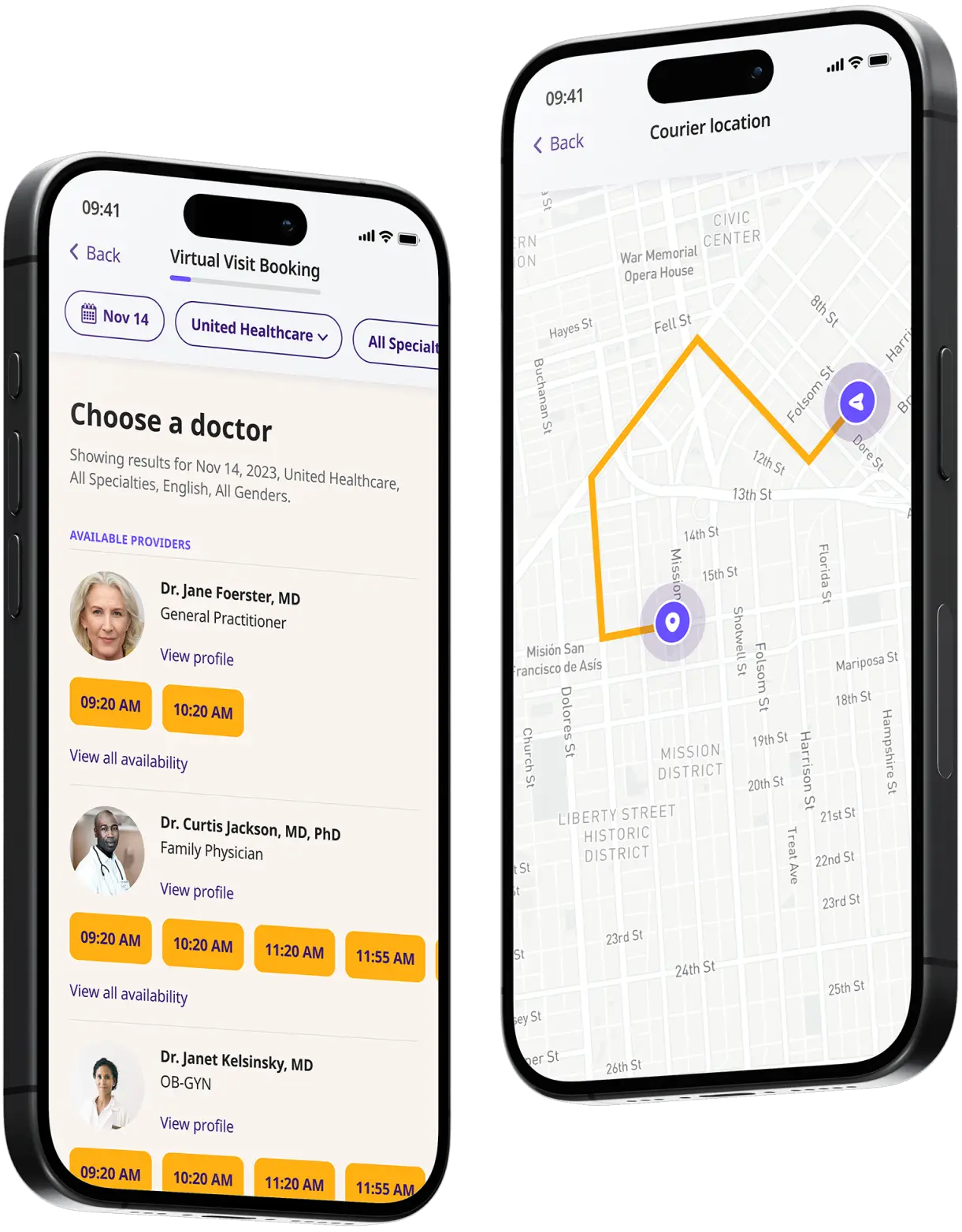Allergy Treatment Online
Find relief from seasonal or chronic allergies. Consult an online doctor 24/7 for fast, personalized treatment.


Available in 50 states. Insurance accepted.
Fast
virtual visits
24/7 care
assistants
Prescriptions
as needed



See If Delivery Is Available Near You
Delivery Not Available
Enter your ZIP code to check if prescription delivery is available in your area and how soon your meds could arrive.
How to get started
Choose your doctor, start a virtual visit, and have your prescriptions sent to your preferred pharmacy for pickup — all in just a few easy steps.
Choose a doctor
Choose a physician by availability, specialty, ratings, and more.

Start a video call
Get connected with a doctor anytime, anywhere.

1-Hour Rx Delivery
Your prescription delivered to your door in 1 hour or less.

Available in 50 states. Insurance accepted.
One-Time
Physician Visit
One-time visit with a physician for diagnosis, treatment, Rx, labs, referrals, and doctor’s notes.
Accepted Insurances
See why people turn to DrHouse...
As seen in

Allergy Treatment Online
Allergies are among the most common chronic conditions worldwide. Essentially, an allergy is a heightened response of the immune system to substances that are generally harmless to most people.
These substances, known as allergens, can trigger an allergic reaction when breathed in, eaten, injected, or touched.
The underlying cause of allergies is the immune system mistakenly identifying a harmless substance as a threat and overreacting to it.
This response can lead to inflammation in the body, which is manifest in various allergic symptoms. Allergens can be found in food, drinks, the environment, and even medications.
Allergies can be more than just an annoying inconvenience, as they can significantly impact quality of life and, in severe cases, be life-threatening.
Common types of allergies include:
- Seasonal allergies (often due to pollen from trees and grasses),
- Food allergies (like nuts, dairy, and shellfish)
- Pet allergies (to dander or hair)
- Drug allergies (like penicillin or aspirin)
Each person’s allergy is unique and can vary in severity from mild irritation to severe and potentially life-threatening reactions, such as anaphylaxis.
Causes of allergies
Allergies occur when the immune system reacts to a foreign substance—such as pollen, bee venom, pet dander, or a particular food—that doesn’t cause a reaction in most people.
Your immune system produces substances known as antibodies. When you have allergies, your immune system makes antibodies that identify a particular allergen as harmful, even though it isn’t. When you come into contact with the allergen, your immune system’s reaction can inflame your skin, sinuses, airways, or digestive system.
The severity of allergies varies from person to person and can range from minor irritation to anaphylaxis, a potentially life-threatening emergency. While most allergies can’t be cured, treatments can help relieve your allergy symptoms.
Common causes of allergic reactions include:
- Pollen, from trees, grasses, and weeds.
- Dust Mites, microscopic organisms that live in household dust.
- Animal Dander, tiny flakes of skin or hair.
- Food, particularly nuts, milk, eggs, shellfish, and wheat.
- Insect Stings, such as from bees or wasps.
- Mold, which reproduces through tiny, airborne spores.
- Medications, including prescription and over-the-counter drugs.
- Latex, found in latex gloves and certain medical devices.
Genetic and environmental factors
Allergies can develop at any age, potentially even from before birth. They commonly occur in children but can trigger later in life. You might develop an allergy to something you had no problem with before because allergies can develop throughout different stages of life.
- Genetic factors play a crucial role in determining who gets allergies. If both of your parents have allergies, you have a higher chance of having allergies too, though the specific allergy or allergies may not be the same.
- Environmental exposure also influences the development of allergies. For instance, exposure to allergens when the body’s defenses are weak, such as during an illness or pregnancy, might trigger alterations in the immune system’s response, leading to an allergic reaction.
Allergy symptoms
Allergic reactions can involve various parts of the body and manifest in different ways, ranging from mild to potentially life-threatening.
The symptoms of allergies depend on the type of allergen, the part of the body where exposure occurs, and the severity of the immune response. Here are some common allergy symptoms categorized by the type of allergen:
Respiratory allergies – These are often triggered by pollen, pet dander, mold, or dust mites:
- Sneezing
- Runny or stuffy nose
- Itchy, watery eyes
- Wheezing and shortness of breath
- Coughing
Food and medication allergies – Reactions can range from mild to severe and typically occur within minutes to a few hours after consumption:
- Swelling of the lips, tongue, face, or throat
- Hives
- Anaphylaxis, a severe, potentially life-threatening reaction that can impair breathing and send the body into shock
Skin allergies – Caused by contact with plants like poison ivy, animal dander, latex, or other irritants:
- Redness
- Itchy skin
- Hives (a rash with raised red patches)
- Eczema (persistent dry, itchy patches)
Insect sting allergies – Reactions to bee stings or other insect bites:
- A large area of swelling (edema) at the sting site
- Itching or hives all over the body
- Cough, chest tightness, wheezing, or shortness of breath
- Anaphylaxis
The intensity of symptoms can vary based on exposure levels and individual sensitivity.
For some, symptoms might be a minor nuisance, but for others, they can be severe enough to interfere with day-to-day activities or even be life-threatening.
How are allergies treated?
Allergy treatments can vary widely based on the severity of symptoms and the nature of the allergen. The goal of treatment is to reduce symptoms and improve quality of life. Here are some of the common approaches to managing and treating allergies:
Avoidance – The most effective treatment for allergies is to avoid the allergens that trigger symptoms:
- For pollen allergies, stay indoors on dry, windy days and use air purifiers to reduce indoor allergens.
- For food allergies, carefully check food labels and be mindful of cross-contamination.
- For dust mite allergies, use allergen-proof bed covers, wash bedding in hot water, and maintain low humidity indoors.
Medications – Allergy medications can help reduce symptoms. The type of medication recommended depends on the severity and type of symptoms:
- Antihistamines (such as loratadine, cetirizine, and fexofenadine) can help with sneezing, runny nose, and itching.
- Decongestants (such as pseudoephedrine) can provide temporary relief from nasal stuffiness.
- Nasal corticosteroids (such as fluticasone, and budesonide) are effective for controlling inflammation and treating chronic symptoms.
- Eye drops and nasal sprays can alleviate conjunctivitis and other related symptoms.
Immunotherapy – For long-term relief, some people undergo immunotherapy, which can be administered through allergy shots or sublingual tablets:
- Allergy shots involve injecting small amounts of allergens over several years to help the body get used to them.
- Sublingual immunotherapy involves placing a tablet containing a small dose of the allergen under the tongue daily.
Emergency epinephrine – For severe allergies, particularly those that could cause anaphylaxis, carrying an epinephrine injector (like an EpiPen) is critical. This provides immediate treatment for allergic reactions, helping to reduce symptoms until medical help can be obtained.
Lifestyle changes – Simple lifestyle changes can also help manage symptoms:
- Using hypoallergenic soaps and detergents
- Installing high-efficiency particulate air (HEPA) filters
- Keeping pets out of certain rooms to reduce dander
Allergy medication
Effective management of allergy symptoms often involves the use of medications designed to control inflammation and alleviate discomfort. Depending on their strength and intended use. these medications can be prescribed by a healthcare provider or available over-the-counter.
Here’s a closer look at the main types of allergy medications:
Antihistamines – Antihistamines are one of the most common treatments for allergy symptoms. They work by blocking histamine, a substance in the body that causes allergy symptoms. They are particularly effective at relieving sneezing, itching, runny nose, and watery eyes.
- Oral antihistamines: Include loratadine (Claritin), cetirizine (Zyrtec), and fexofenadine (Allegra).
- Nasal sprays: Such as azelastine (Astelin, Astepro).
- Eye drops: Ketotifen fumarate (Alaway, Zaditor) for itchy eyes.
Decongestants – Decongestants help relieve nasal and sinus congestion and are often used in combination with antihistamines for treating allergies.
- Oral decongestants: Include pseudoephedrine (Sudafed) and phenylephrine.
- Nasal sprays: Oxymetazoline (Afrin) and phenylephrine; these are recommended for short-term use only as prolonged use can cause rebound congestion.
Nasal corticosteroids – Nasal corticosteroids are considered one of the most effective treatments for allergic rhinitis. They reduce inflammation in the nasal passages and help relieve nasal congestion, sneezing, and runny nose.
- Sprays: Such as fluticasone (Flonase), budesonide (Rhinocort), and mometasone (Nasonex).
Leukotriene inhibitors – Leukotriene inhibitors block the action of leukotrienes, another chemical that contributes to allergic reactions. They are often prescribed when nasal corticosteroids and antihistamines are not effective.
- Oral medications: Montelukast (Singulair) is a common example.
Mast cell stabilizers – Mast cell stabilizers help prevent the release of histamine and other chemicals from mast cells in the body, thereby reducing allergy symptoms.
- Nasal sprays: Such as cromolyn sodium (NasalCrom).
- Eye drops: Cromolyn sodium is also available for treating allergic conjunctivitis.
Immunomodulators – Topical immunomodulators can help treat skin reactions like eczema and are used when other treatments are ineffective or inappropriate.
- Creams: Such as tacrolimus (Protopic) and pimecrolimus (Elidel).
How can telehealth help with allergies?
Telehealth has become a vital tool in managing allergies, providing several significant benefits, such as:
- Convenient Access to Specialists: Telehealth platforms like DrHouse make it easier to consult with allergy specialists or general practitioners without the need for travel, which is especially beneficial for those in remote or underserved areas.
- Immediate Consultations: For sudden allergy flare-ups or reactions, telehealth can facilitate quick access to medical advice, potentially reducing the need for emergency room visits.
- Ongoing Management: Telehealth allows for consistent follow-up appointments, necessary for adjusting treatment plans or medications based on the effectiveness or side effects experienced by the patient.
- Personalized Advice: Telehealth visits provide an opportunity for detailed education on allergy management, including advice on avoiding allergens, using medications correctly, and recognizing symptoms that necessitate a change in treatment.
- Medication management: Doctors can prescribe or renew prescriptions through telehealth services, ensuring that patients always have access to necessary medications. This is especially useful for routine, maintenance medications such as nasal corticosteroids or montelukast.
- Reduced Exposure: For allergy sufferers, especially those with severe respiratory symptoms, avoiding unnecessary exposure to external allergens and illnesses (like those in a clinic or hospital environment) can be another significant benefit.
Telehealth not only streamlines the process of managing allergies but also enhances patient education, safety, and convenience, making it a valuable component of modern healthcare services for allergy sufferers.
Why Choose DrHouse?
Choosing DrHouse for your telehealth needs comes with a range of benefits tailored to improve accessibility, efficiency, and overall patient satisfaction in managing health concerns, including allergies.
Here’s why DrHouse stands out as a preferred provider:
- Nationwide availability: DrHouse services are available across all 50 states, ensuring that you can access medical care no matter where you are located.
- 24/7 availability: Healthcare professionals are available around the clock, providing on-demand virtual visits and continuous support, which is especially valuable for urgent care situations or sudden allergy flare-ups.
- Quick consultations: The average wait time for a virtual visit is less than 15 minutes, making it a time-efficient option for busy individuals.
- Immediate prescription service: If a prescription is needed, it can be processed during the virtual visit and sent directly to a pharmacy of your choice, either for pick-up or delivery.
- Transparent pricing: DrHouse offers upfront pricing details. Consultations cost between $0 and $129, depending on insurance coverage, with many services having a typical copay of around $25.
- No Insurance needed: Services are accessible even without insurance, which is a significant advantage for those who are uninsured or underinsured.
- Wide range of services: From allergy treatment to urgent care and chronic disease management, DrHouse provides a comprehensive range of telehealth services.
- Prescription policy: DrHouse can prescribe a wide array of medications and manage refills, although they do not prescribe controlled substances or certain specific medications like Gabapentin.
- Experienced providers: All healthcare providers are board-certified and have an average of 20 years of experience, ensuring high-quality medical care.
- HIPAA compliance: DrHouse adheres strictly to HIPAA regulations to ensure the privacy and security of your medical information.
- User-friendly platform: The DrHouse app and website are designed for ease of use, enabling quick booking of appointments, consultation management, and access to medical records.
Choosing DrHouse for telehealth services means choosing a reliable, accessible, and patient-centric healthcare solution that prioritizes your health and convenience, making it an excellent choice for anyone seeking effective and efficient medical care online.
Frequently asked questions (FAQ)
How can I control my allergy symptoms?
There are several ways to control allergy symptoms, including avoiding allergens, taking prescribed medications, and using home remedies such as nasal rinses or steam inhalation. Consulting with a healthcare professional can also provide personalized advice on managing your specific allergies effectively.
Is it safe to use telehealth for my allergies?
Yes, it is safe to use DrHouse for telehealth services related to allergies. All healthcare providers are board-certified and have extensive experience in managing various health concerns, including allergies. Additionally, DrHouse adheres strictly to HIPAA regulations to ensure the privacy and security of your medical information.
Can I get an online prescription for allergy medication from DrHouse?
Yes, DrHouse can prescribe a wide range of medications for allergy management. Depending on your providers’ assessment during the virtual visit, they may prescribe or renew prescriptions for medications such as antihistamines, nasal corticosteroids, or rescue inhalers.
Related services
Explore more of our services tailored to your needs and discover additional ways we can support your healthcare needs.
Frequently asked questions



